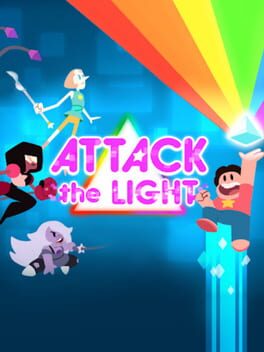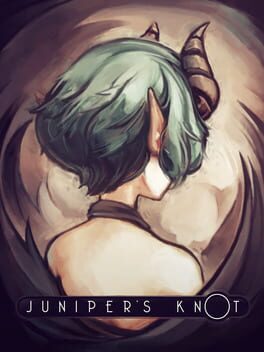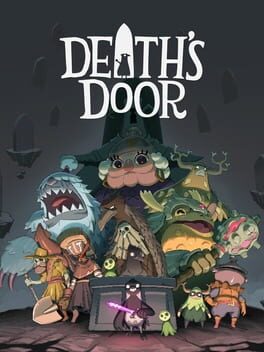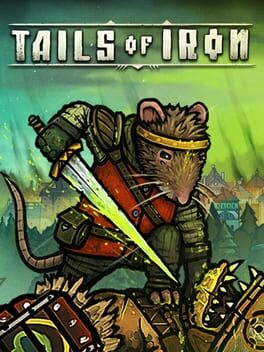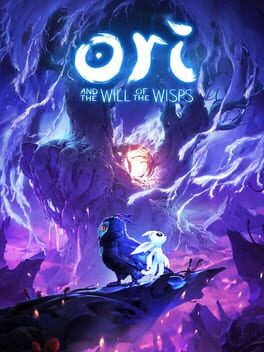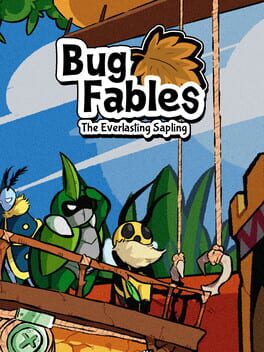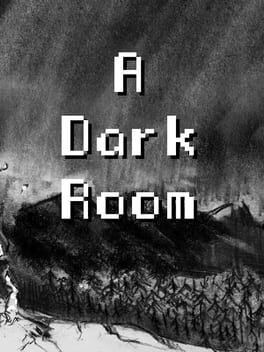DouDou
13 reviews liked by DouDou
Attack the Light!
2015
Steven Universe is my all time favorite cartoon. Hell, it may be my favorite piece of media, period. So when it came time to get some video games, I was surprised just how much love the series was given. Cartoon Network teamed with little mobile developer Grumpyface Studios and thus was born the "Light Trilogy," a canon trilogy of RPGs set in the world of Steven Universe. I have never played the last two, but I was saving them for a special time, now that Steven Universe proper has been done for over a year and this is the last bits of worthwhile SU media I have not yet experienced. I did beat Attack the Light years ago, but I figured I'd judge the trilogy as a whole.
Being a mobile game, this game is short. I blasted through a pretty casual 100% hard mode run over the course of two days. But for a mobile game, this is surprisingly high quality. Enemy variety is great, the music sounds appropriate for the show, and the chibi art style is endearing, but the star of the show is the Paper Mario influence. When your basic attack begins, you can tap the screen just as it connects to do a combo move, and when you get attacked, you can tap at just the right time to halve the damage. On hard mode, you can't see the special indicators of when to tap, but it's still easy to figure out if you basic pattern recognition. The star system is also brilliant. Your actions cost star points and you can only use one item from your inventory per turn, so it's on you to risk and reward conserving stars for a big fuck-off turn, or spend them all immediately to draw aggro or do small, instant damage. There's even a badge system. I also love the role Steven plays in this game. At this point in the story of the show, Steven hasn't yet unlocked his fighting capabilities, so he's the healer, bard and item distributor. I also like the gag where Steven starts out at level 1 whereas the Gems start at level 9001. Cute touch.
The biggest problems with the game are the basic story, controls and items. The story is inoffensive and basic, like the most "this is a video game based on a pre-existing property" kind of story, but thankfully the later two games rectify this issue. The controls work for the most part, but occasionally a group of enemies will be too clustered together, so when I meant to tap on one for a target, sometimes it would target a different close-by enemy, which was annoying. The balancing is kinda fucky, too. Garnet is supposed to be the beefy tank, Amethyst the weaker, critical-hit based multi-target attacker, and Pearl is the character you use to pick off squishies with little cost. I guess I accidentally spec-ed Pearl into DPS, though. Garnet's basic attack is a single-target two-cost, but Pearl's is the same but it's one cost. She would do a little bit less than, the same, or even more damage from one attack than Garnet could, but since I could pop two Pearl attacks in what would take Garnet one, I kept relying on Pearl for damage. The economy is also for shit. At the start of the game you never have enough money, and then once you reach the halfway point, you always have enough money. I wish you could sell items, but you can't. Star fruits that give me extra star points, healing items, and reviving items were the only ones I ever used. I didn't ever touch my status effect items, yet I had about a hundred of them in total just cluttering my bag. The final boss was also piss easy. Since you start the fight will full health, I just popped one of my "next action costs 0 star points" items, used my once-per-fight fusion, and ate half its health bar, dropping its attack and defense stats while doing so.
Attack the Light is a humble beginning for the Light Trilogy and it's clear that Save and Unleash have both built upon and improved the groundwork laid out by this first game. If you're looking for a Paper Mario-esque RPG to play over a lazy weekend, I do recommend this game, especially for the low cost of $3. You don't even need to be a fan of the show to enjoy the game. But the other two are definitely more fan-oriented. But that's okay because Steven Universe is literally the best thing ever just watch it you cowards.
Being a mobile game, this game is short. I blasted through a pretty casual 100% hard mode run over the course of two days. But for a mobile game, this is surprisingly high quality. Enemy variety is great, the music sounds appropriate for the show, and the chibi art style is endearing, but the star of the show is the Paper Mario influence. When your basic attack begins, you can tap the screen just as it connects to do a combo move, and when you get attacked, you can tap at just the right time to halve the damage. On hard mode, you can't see the special indicators of when to tap, but it's still easy to figure out if you basic pattern recognition. The star system is also brilliant. Your actions cost star points and you can only use one item from your inventory per turn, so it's on you to risk and reward conserving stars for a big fuck-off turn, or spend them all immediately to draw aggro or do small, instant damage. There's even a badge system. I also love the role Steven plays in this game. At this point in the story of the show, Steven hasn't yet unlocked his fighting capabilities, so he's the healer, bard and item distributor. I also like the gag where Steven starts out at level 1 whereas the Gems start at level 9001. Cute touch.
The biggest problems with the game are the basic story, controls and items. The story is inoffensive and basic, like the most "this is a video game based on a pre-existing property" kind of story, but thankfully the later two games rectify this issue. The controls work for the most part, but occasionally a group of enemies will be too clustered together, so when I meant to tap on one for a target, sometimes it would target a different close-by enemy, which was annoying. The balancing is kinda fucky, too. Garnet is supposed to be the beefy tank, Amethyst the weaker, critical-hit based multi-target attacker, and Pearl is the character you use to pick off squishies with little cost. I guess I accidentally spec-ed Pearl into DPS, though. Garnet's basic attack is a single-target two-cost, but Pearl's is the same but it's one cost. She would do a little bit less than, the same, or even more damage from one attack than Garnet could, but since I could pop two Pearl attacks in what would take Garnet one, I kept relying on Pearl for damage. The economy is also for shit. At the start of the game you never have enough money, and then once you reach the halfway point, you always have enough money. I wish you could sell items, but you can't. Star fruits that give me extra star points, healing items, and reviving items were the only ones I ever used. I didn't ever touch my status effect items, yet I had about a hundred of them in total just cluttering my bag. The final boss was also piss easy. Since you start the fight will full health, I just popped one of my "next action costs 0 star points" items, used my once-per-fight fusion, and ate half its health bar, dropping its attack and defense stats while doing so.
Attack the Light is a humble beginning for the Light Trilogy and it's clear that Save and Unleash have both built upon and improved the groundwork laid out by this first game. If you're looking for a Paper Mario-esque RPG to play over a lazy weekend, I do recommend this game, especially for the low cost of $3. You don't even need to be a fan of the show to enjoy the game. But the other two are definitely more fan-oriented. But that's okay because Steven Universe is literally the best thing ever just watch it you cowards.
Juniper's Knot
2012
Death's Door
2021
Tails of Iron
2021
Tails of Iron is a surprisingly messy affair, both in terms of the amount of frog blood our heroic rodent Redgi spills over the course of his journey and in terms of flow and polish. With a well-executed first act focused on simple tasks and easy enemies, the game puts a strong foot forward and allows you to experience its best aspects: the art style, music and overall world feel. Make no mistake though: Tails of Iron, even as it opens up, is not a Metroidvania. Curiosity-driven exploration takes a backseat as you accept side quests that put a marker on your map. You will then head to what was most likely a formerly empty dead end, fight a few enemies and return to reap the quest's rewards. Yes, there are a few optional bosses to find and conquer, but apart from the occasional weapon or armor piece hidden in plain sight, freeform spelunking is somewhat discouraged. Main quests are more elaborate, but fundamentally work the same way.
One of the two big problems Tails of Iron has is its map. While things certainly ramp up towards the end, with one surprisingly funny area being a standout (you'll know it when you get there), most of ToI's second act is spent in less than exciting tunnels, caves and other kinds of below-ground locales. While most games released in the last few years almost cheekily dance around the dreaded sewer level, this ratventure really takes the plunge and serves up not one, but two (technically three) major underground areas back to back. Weirdly brave, yes, but also surpremely unexciting to traverse.
The second issue lies with the way enemies react to you, and vice versa. Some reviews praise Tails of Iron for its combat, one even going so far as to suggest it as an ideal entry point for people who are entirely new to the Souls-adjecant school of methodical action combat. I absolutely do not share this sentiment. While early encounters and most regular enemies are fun enough to handle and don't pose much of a threat once you get to grips with the controls, pretty much every boss battle is an exercise in frustration thanks to extremely fast, barely telegraphed gotcha-type attacks that deal huge amounts of damage. I tweeted earlier that bosses in ToI feel like "playing Hollow Knight as a heavy-rolling Dark Souls 1 tank build", which is probably a dumb comparison, but it's also the most accurate mental picture I can think of. The complete (?) absence of dodge roll iframes on your character and enemies aggressively auto-dodging your attacks if they aren't in a vulnerable state transform combat scenarios into an almost turn-based affair. Sneaking in extra hits to speed up fights, something we all love to do if we feel cocky, is either way too dangerous or straight up not possible. Your secondary weapons and tools will certainly help to alleviate some of the challenge – and to be fair, every boss can be beaten after a few tries – but the later ones in particular still feel designed to catch you off guard on your first attempt.
If you happen to thoroughly enjoy the game's combat, there is a great 10-hour package waiting here, despite the environmental shortcomings. Personally, I found ToI's battles to be both undercooked and overtuned, which makes it hard for me to recommend this game to action fans. The story and overall presentation are pretty strong, especially for a smaller team, but the lack of assist options means I also cannot recommend it as a purely story-driven experience.
Part of me wants to love this game, but unfortunately, its big flaws are almost always present on the screen in some shape or form.
One of the two big problems Tails of Iron has is its map. While things certainly ramp up towards the end, with one surprisingly funny area being a standout (you'll know it when you get there), most of ToI's second act is spent in less than exciting tunnels, caves and other kinds of below-ground locales. While most games released in the last few years almost cheekily dance around the dreaded sewer level, this ratventure really takes the plunge and serves up not one, but two (technically three) major underground areas back to back. Weirdly brave, yes, but also surpremely unexciting to traverse.
The second issue lies with the way enemies react to you, and vice versa. Some reviews praise Tails of Iron for its combat, one even going so far as to suggest it as an ideal entry point for people who are entirely new to the Souls-adjecant school of methodical action combat. I absolutely do not share this sentiment. While early encounters and most regular enemies are fun enough to handle and don't pose much of a threat once you get to grips with the controls, pretty much every boss battle is an exercise in frustration thanks to extremely fast, barely telegraphed gotcha-type attacks that deal huge amounts of damage. I tweeted earlier that bosses in ToI feel like "playing Hollow Knight as a heavy-rolling Dark Souls 1 tank build", which is probably a dumb comparison, but it's also the most accurate mental picture I can think of. The complete (?) absence of dodge roll iframes on your character and enemies aggressively auto-dodging your attacks if they aren't in a vulnerable state transform combat scenarios into an almost turn-based affair. Sneaking in extra hits to speed up fights, something we all love to do if we feel cocky, is either way too dangerous or straight up not possible. Your secondary weapons and tools will certainly help to alleviate some of the challenge – and to be fair, every boss can be beaten after a few tries – but the later ones in particular still feel designed to catch you off guard on your first attempt.
If you happen to thoroughly enjoy the game's combat, there is a great 10-hour package waiting here, despite the environmental shortcomings. Personally, I found ToI's battles to be both undercooked and overtuned, which makes it hard for me to recommend this game to action fans. The story and overall presentation are pretty strong, especially for a smaller team, but the lack of assist options means I also cannot recommend it as a purely story-driven experience.
Part of me wants to love this game, but unfortunately, its big flaws are almost always present on the screen in some shape or form.
Death's Door
2021
Death's Door, the second game by Acid Nerve (of Titan Souls fame) is, at its core, an extremely competent adaption of the classic 2D Zelda formula. Your journey as the Crow, a lowly worker in some sort of bureaucratic afterlife, will take you through several different areas in which you solve little puzzles, talk to NPCs, battle enemies and carefully observe the environment in order to figure out how to access hidden items and upgrades.
When you aren't looking at the beautiful isometric maps that are distinct enough to make the lack of a map feature a non-issue (seriously, this game has some A+ natural navigation), you're probably fighting a bunch of enemies. Combat is, at its core, a somewhat simple affair, but with the added benefit of several multi-purpose tools (your basic attack is also your projectile parry, your grappling hook will eventually become an offensive tool, and so on), exploitable environmental hazards and surprisingly aggressive enemies, you get a decent package that encourages free-form combat as much as this kind of game can. Bosses are a bit more traditional and, for the most part, provide great exclamation points for one part of the game before moving on to the next.
Unlike some genre contemporaries, Death's Door pretty much throws side content out of the window and puts the focus on engaging exploration. Of course, not every area is a winner (the forest overworld might be a bit too convoluted for its own good) and while the encounters feel as deliberate and hand-crafted as they are, more opportunities to play around with late-game upgrades would've been nice. Thankfully, the game's excellent audiovisual presentation combined with its endearing, yet never overly chatty writing, rarely allows for a dull moment.
Death's Door also wins my hypothetical "Best True Ending" award this year, because despite some heavy hints in the game's second half, it's something I did not see coming.
If you're looking for a fun and polished action adventure experience, the ten to fifteen hours you will spend with this game are well worth your time.
When you aren't looking at the beautiful isometric maps that are distinct enough to make the lack of a map feature a non-issue (seriously, this game has some A+ natural navigation), you're probably fighting a bunch of enemies. Combat is, at its core, a somewhat simple affair, but with the added benefit of several multi-purpose tools (your basic attack is also your projectile parry, your grappling hook will eventually become an offensive tool, and so on), exploitable environmental hazards and surprisingly aggressive enemies, you get a decent package that encourages free-form combat as much as this kind of game can. Bosses are a bit more traditional and, for the most part, provide great exclamation points for one part of the game before moving on to the next.
Unlike some genre contemporaries, Death's Door pretty much throws side content out of the window and puts the focus on engaging exploration. Of course, not every area is a winner (the forest overworld might be a bit too convoluted for its own good) and while the encounters feel as deliberate and hand-crafted as they are, more opportunities to play around with late-game upgrades would've been nice. Thankfully, the game's excellent audiovisual presentation combined with its endearing, yet never overly chatty writing, rarely allows for a dull moment.
Death's Door also wins my hypothetical "Best True Ending" award this year, because despite some heavy hints in the game's second half, it's something I did not see coming.
If you're looking for a fun and polished action adventure experience, the ten to fifteen hours you will spend with this game are well worth your time.
Hunt: Showdown
2019
Really enjoyable to play, until you get blasted four or more games in a row and you wonder if you should have just played something else instead.
I probably wouldn't play this on my own and while it is viable to do so, it just feels like the game is built perfectly to play with others. The small lulls inbetween running towards clues or bosses give perfect amounts of time to relax and talk, while the tense moments like fighting a team make you concentrate to make sure you haven't wasted your time running across the map.
My only two issues are really that losing hunters isn't really that big of a deal, you think it would be when you start playing but you just get a new one so it isn't really that bad. And the prestige system doesn't really seem worth it, but maybe that's just me. Other than that, overall, a really enjoyable game.
I probably wouldn't play this on my own and while it is viable to do so, it just feels like the game is built perfectly to play with others. The small lulls inbetween running towards clues or bosses give perfect amounts of time to relax and talk, while the tense moments like fighting a team make you concentrate to make sure you haven't wasted your time running across the map.
My only two issues are really that losing hunters isn't really that big of a deal, you think it would be when you start playing but you just get a new one so it isn't really that bad. And the prestige system doesn't really seem worth it, but maybe that's just me. Other than that, overall, a really enjoyable game.
A perfect sequel to a great game, this is like Ori and the Blind Forest had a baby with Hollow Knight. The combat is not quite as tough as the latter, but that's more than made up for by the ridiculous platforming. Seriously, it's bonkers. (in a good way) The only complaint I really have is that the story is just kind of a rehash of the first game, and a lot of parts feel repetitive (there are of course many of those signature chase sequences throughout). To this games credit, however, the boss fights here and combat in general are a million miles ahead of it's predecessor. As is to be expected, the music and visuals are just as beautiful as always, especially with HDR and higher quality assets.
A low-stats, badge-based, action-commands, overworld-explorin' RPG about a plucky trio of bug adventurers which proudly wears its inspirations of the first two (and only good two) Paper Mario games on its sleeve. Bug Fables has a simple, charming main storyline, but a surprising amount of sidequests, challenges, minigames, side areas, even a freakin' card game; highly recommended and an absolute must-play for Paper Mario fans.
Oh btw, did you guys know that you can play that card game online? Link: https://spy-cards.lubar.me/
Oh btw, did you guys know that you can play that card game online? Link: https://spy-cards.lubar.me/
A Dark Room
2013
Minimalism and expansion are the twin principles here. Minimalism that drip-feeds your complicit imagination; expansion that is not about accumulation but level-shifting. Together they twist your expectations – just as you master one rhythm, the music changes. If A Dark Room doesn’t deepen much upon replay, there’s still nothing like your first time.
So the less said, the better. But if you want more, you’ve been warned.
Why so rapacious? Why explore a system, a world anyway? Where does it end? For when wonder yields to hunger, unsatisfied, unsatisfiable, we end up alone, in rooms, playing endless games in the dark.
So the less said, the better. But if you want more, you’ve been warned.
Why so rapacious? Why explore a system, a world anyway? Where does it end? For when wonder yields to hunger, unsatisfied, unsatisfiable, we end up alone, in rooms, playing endless games in the dark.
